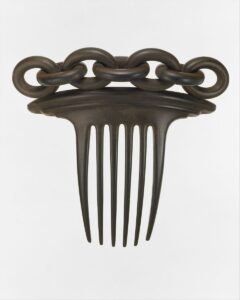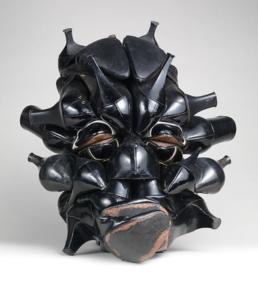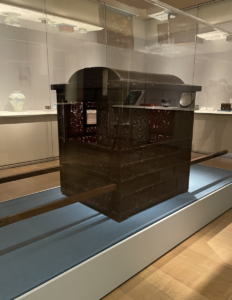This week we attended the Met Museum, where we went to see the “Before We Can Fly Away” Exhibit. The exhibit was interesting because it showed an inside home of African Americans. Especially, there were little accessories or parts of an object shown through the exhibition while showing the significance of the items. The met showed the homes of the African Americans based in the Seneca Village.
As I was looking through the exhibit, the hair comb caught my attention. The hair comb was small and was made with “Malaysian gutta-percha resin.” The design of the comb showed a chain, which symbolized the agonizing past that Blacks had to go through. The comb lines are short because they represent the little freedom they had before thinking they were endangered again.
Title: Hair Comb, Date: ca. 1851, Medium: Vulcanite (India rubber and sulfur), Dimensions: 4 1/4 x 4 1/2 in. (10.8 x 11.4 cm).
Another piece that I found interesting was called “Shine,” which Wille Cole did. Cole used many “high heel leather shoes” and combined them all. He wanted to show that he took unwanted items into gave them a new meaning. As well as he played with the word “sole,” which can also sound like “soul.” He took that and demonstrated how the shoes are another way of remembering those memories. The reason is that many different people wear shoes, regards who they are. You can see the bunch of heels combining and creating a face as if it shows a person or whoever has worn them. It was becoming one.
Title: Shine, Artist: Willie Cole (American, born Newark, New Jersey, 1955), Date: 2007, Medium: Shoes, steel wire, monofilament line, washers, and screws, Dimensions: 16 × 14 × 16 in., 11.7 lb. (40.6 × 35.6 × 40.6 cm).
Besides looking at the “Before We Can Fly Away” exhibit, I checked out the Asian exhibit section. I took a look at the Korean exhibition, which showed a bunch of amazing and unique designs on a box and vases. As well as, I was able to watch a small clip of how it was created. I found it fascinating how they work step by step to create a beautiful natural design on the box representing the Asian. One thing that caught my eyes was the “Palanquin,” which was a transportation kind of form. Women mostly used it. In the mid-twentieth century, the Palanquin was used for ceremonial purposes. It was used for the bride to go to her wedding. It was huge, so there was enough space where the women sat. There are two sticks in the front and back to use the Palanquin. The men lifted that part to carry the women to their destination. As well as, there is a big window if the person wants to look outside.
Title: Palanquin, Date: 20th century, Medium: Lacquered wood with paper, cellulosic acetate and silk cushion, Dimensions: Rectangular housing (incl. domed top): 43 1/2 × 33 3/4 × 29 3/4 in., 88 lb. (110.5 × 85.7 × 75.6 cm), Dims & weight of the poles (each): 1 1/8 in. × 8 ft. 9 5/8 in. × 1 1/2 in., 7 lb. (2.9 × 268.3 × 3.8 cm, 3175.179g).





